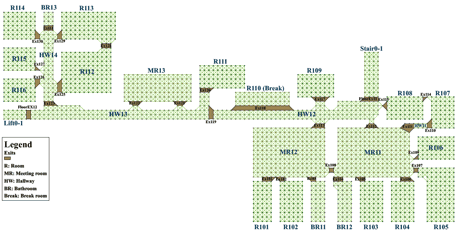by Imad Afyouni, Cyril Ray and Christophe Claramunt
Despite the continuous development and improvements made in mobile computing and the variety of technologies that can be used to enable ambient indoor environments, there are still many research challenges in this area that need to be addressed. Spatial data representation and management as well as location-dependent query processing are among current issues to be coped with so that an efficient and sufficiently flexible indoor context-aware navigation system can be designed.
A key enabler of mobile computing, apart from the networking infrastructure, is the successful integration of semantics and advanced reasoning techniques into mobile information systems. These features have been recently characterized under the Ambient Intelligence (AmI) technologies. The range of applications in ambient information systems is progressively evolving from large to small scale environments. In particular, there is a growing need for applications that assist humans in their navigation-related activities in indoor spaces (eg, airports, museums, office buildings). A successful integration of indoor knowledge representation and ambient systems still requires the development of appropriate spatial data structures and data management facilities. We believe that this is mandatory for the delivery of intelligent and context-aware systems applied to indoor spaces.
Location-dependent queries and more generally context-dependent queries appear to have considerable impact for the development of different categories of such location-based and context-aware services. The context-dependent character of these queries means that any change in the context (eg, changes in the locations and profiles of the objects that are involved in the query) may significantly affect the answer. As these queries are time-sensitive and location-dependent, they may be valid only for a given period of time and within a given area. Therefore, these queries are expected to be processed as continuous queries, meaning that the system should continually keep the answers up-to-date, until the query is explicitly cancelled by the user. A unique combination of challenges arises with location- and context-aware services and queries in indoor environments, as researchers must be able to represent different kinds of location-dependent and user-centred queries (typically path search and range queries) in a flexible manner, and to take into account additional context information, time-dependency, and the hierarchical layout of the indoor environment.
Indoor space modelling is the core element to be investigated for advanced services [1]. We postulate that modelling and designing a hierarchically organized context-dependent indoor data model is the best way to satisfy a wide range of location-based services. Such a data model can be viewed as a tree structure in which location information is represented at different levels of abstraction: (1) a fine-grained graph embedded within an occupancy grid (Figure 1); (2) an exit hierarchy (Figure 2); and (3) a location hierarchy (Figure 3). Moreover, such a model is able to represent: (i) static/moving features of interest, (ii) their spatial properties, and (iii) the behaviours or actions that emerge from them. The hierarchical design alleviates performance and scalability issues in location dependent query processing. In addition, time-dependent functions that compute the network distance and the travel time are introduced. Furthermore, a classification of user profiles is possible in order to perform an offline filtering of the multilevel data model, thus reducing the amount of data that need to be processed in real-time.

The semantics of a query grammar tied to the indoor data model have also been developed [2]. Such a grammar is required to express location-dependent queries. It supports navigation queries and incorporates some other preferences and semantics in the query model. It also supports the hierarchical data model by using the concept of location granules to represent the different levels of abstraction. The use of the location granules concept allows formulation of queries using the location terminology required by the user (eg, vertices at the fine-grained level, rooms, floors, buildings, etc.).


We designed algorithms and a generic architecture usable for the continuous processing of location-dependent queries in indoor environments [3]. Navigation-related queries are processed in accordance with this architecture, and are executed continuously while the request is not explicitly cancelled by the user. Particularly, algorithms for hierarchical path searches and range queries applied to both static and moving objects have been developed [3]. These algorithms take advantage of the hierarchical data model of the indoor environment, and employ an incremental approach in order to efficiently execute continuous location-dependent queries, thus avoiding solving each search problem independently from scratch. Our design and implementation rely on a database extension based on the open source DBMS PostgreSQL. The main parts of the prototype developed are: (i) the hierarchical network-based data model of the indoor environments; (ii) the operators and location-dependent constraints introduced in the query grammar; and (iii) the algorithms to process continuous location-dependent queries over moving objects.
To conclude, a successful integration of indoor knowledge representation and mobile information systems requires the development of hierarchical spatial data models. These models should support continuous processing of location-dependent queries applied to moving objects acting in these environments. This is exactly the scope of the approach that has been developed by our research. Application perspectives are very large, from the development of interactive systems for built environments, to additional professional- and user-oriented services. Not only are the application perspectives promising, but there is also great potential for business as the range of possibilities will surely open many opportunities.
Link:
Naval Academy Research Institute: http://irenav.fr
References:
[1] I. Afyouni et al: “Spatial Models for Indoor Context-Aware Navigation Systems: A Survey”, JOSIS, 4(1), 85-123, 2012
[2] I. Afyouni et al: “Context-aware modelling of continuous location-dependent queries in indoor environments”, JAISE, IOS Press, 5(1):65-88, 2013
[3] I. Afyouni et al: “Algorithms for continuous location-dependent and context-aware queries in indoor environments”, ACM SIGSPATIAL 2012, 329-38.
Please contact:
Imad Afyouni and Cyril Ray and Christophe Claramunt
Naval Academy Research Institute, France
E-mail: {imad.afyouni, cyril.ray, christophe.claramunt}@ecole-navale.fr











